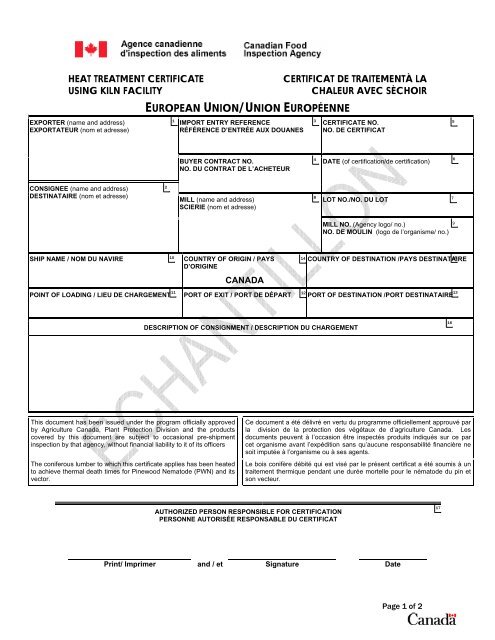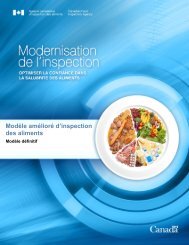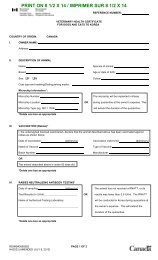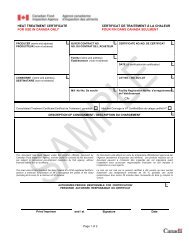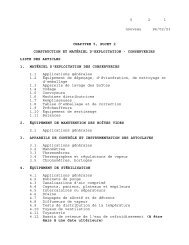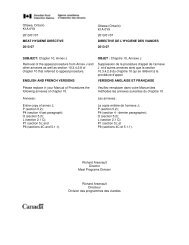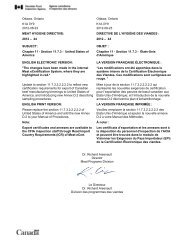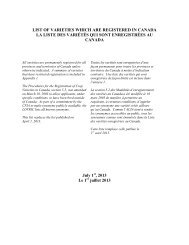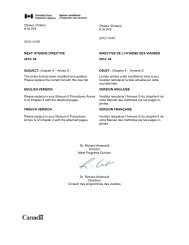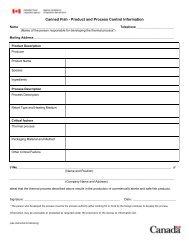PDF (225 ko ) - Agence canadienne d'inspection des aliments
PDF (225 ko ) - Agence canadienne d'inspection des aliments
PDF (225 ko ) - Agence canadienne d'inspection des aliments
You also want an ePaper? Increase the reach of your titles
YUMPU automatically turns print PDFs into web optimized ePapers that Google loves.
HEAT TREATMENT CERTIFICATE<br />
USING KILN FACILITY<br />
EXPORTER (name and address)<br />
EXPORTATEUR (nom et adresse)<br />
EUROPEAN UNION/UNION EUROPÉENNE<br />
IMPORT ENTRY REFERENCE<br />
RÉFÉRENCE D’ENTRÉE AUX DOUANES<br />
CERTIFICAT DE TRAITEMENTÀ LA<br />
CHALEUR AVEC SÈCHOIR<br />
CERTIFICATE NO.<br />
NO. DE CERTIFICAT<br />
1 3 5<br />
BUYER CONTRACT NO.<br />
NO. DU CONTRAT DE L’ACHETEUR<br />
DATE (of certification/de certification)<br />
4 6<br />
CONSIGNEE (name and address)<br />
DESTINATAIRE (nom et adresse)<br />
2<br />
MILL (name and address)<br />
SCIERIE (nom et adresse)<br />
8<br />
LOT NO./NO. DU LOT<br />
7<br />
MILL NO. (Agency logo/ no.)<br />
NO. DE MOULIN (logo de l’organisme/ no.)<br />
9<br />
SHIP NAME / NOM DU NAVIRE<br />
COUNTRY OF ORIGIN / PAYS<br />
D’ORIGINE<br />
CANADA<br />
COUNTRY OF DESTINATION /PAYS DESTINATAIRE<br />
10 14 15<br />
11 12 13<br />
POINT OF LOADING / LIEU DE CHARGEMENT PORT OF EXIT / PORT DE DÉPART PORT OF DESTINATION /PORT DESTINATAIRE<br />
DESCRIPTION OF CONSIGNMENT / DESCRIPTION DU CHARGEMENT<br />
16<br />
This document has been issued under the program officially approved<br />
by Agriculture Canada, Plant Protection Division and the products<br />
covered by this document are subject to occasional pre-shipment<br />
inspection by that agency, without financial liability to it of its officers<br />
The coniferous lumber to which this certificate applies has been heated<br />
to achieve thermal death times for Pinewood Nematode (PWN) and its<br />
vector.<br />
Ce document a été délivré en vertu du programme officiellement approuvé par<br />
la division de la protection <strong>des</strong> végétaux de d’agriculture Canada. Les<br />
documents peuvent à l’occasion être inspectés produits indiqués sur ce par<br />
cet organisme avant l’expédition sans qu’aucune responsabilité financière ne<br />
soit imputée à l’organisme ou à ses agents.<br />
Le bois conifère débité qui est visé par le présent certificat a été soumis à un<br />
traitement thermique pendant une durée mortelle pour le nématode du pin et<br />
son vecteur.<br />
AUTHORIZED PERSON RESPONSIBLE FOR CERTIFICATION<br />
PERSONNE AUTORISÉE RESPONSABLE DU CERTIFICAT<br />
17<br />
Print/ Imprimer and / et Signature Date<br />
Page 1 of 2
USE OF CERTIFICATE<br />
Shall only be issued by Grading Agencies, Mills or Shippers approved by the<br />
Canadian Food Inspection Agency.<br />
1. Exporter - For optional use of exporter.<br />
2.Consignee - For optional use of exporter<br />
3. Import Entry Reference - For use by country to which document is directed.<br />
4. Contract No. - The Buyer contract number<br />
5. Certificate No. - Refers to a number to be assigned by the authorized issuing<br />
mill/shipper/Agency. Each certificate must bear an individual number so as to<br />
clearly identify each individual certificate. This is required by the Canadian Food<br />
Inspection Agency.<br />
6. Date of Certification - Refers to the date on which the certification occurred.<br />
7. Lot No. - Refers to the mill lot number of the lumber.<br />
8. Mill - Refers to the mill name or Division and provi<strong>des</strong> the address. This<br />
information may be pre-printed on to the Certificate.<br />
9. Mill No. (Or Shipper No.) - Refers to an approval number assigned by the<br />
Canadian Food Inspection Agency to approved participants in the program. To<br />
avoid confusion the number may correspond to mill numbers as provided by<br />
grading agencies. Only mill/shipper /Agencies listed with and approved by CFIA<br />
may participate in the program. The mill number may be pre-printed on to the<br />
certificate. It consists of two parts, a grading agency logo and a number.<br />
10. Ship name - For optional use of exporter.<br />
11. Point of Loading - For optional use of exporter.<br />
12. Port of Exit - For optional use of exporter.<br />
13. Port of Destination - For optional use of exporter.<br />
14. Country of Origin - Canada<br />
15. Country of Destination - These certificates may only be used for lumber<br />
<strong>des</strong>tined to countries who have approved their use.<br />
16. Description of Consignment - Must include information on the species, marks,<br />
gra<strong>des</strong>, numbers of packages, lot or bundle numbers, volume and other<br />
appropriate <strong>des</strong>criptors. If space on the form is insufficient, attach additional<br />
pages, and indicate on face of Certificate, in the “Description of Consignment”<br />
block, the number of supplementary pages appended. These additional pages must<br />
bear the mill number, certificate number and signature.<br />
If an aggregated consignment is based on numerous certificates, list individual<br />
certificate numbers (i.e., mill numbers, certificate numbers and dates) on the single<br />
certificate <strong>des</strong>cribing the aggregated consignment. The individual certificates need<br />
not accompany the goods. This single certificate constitutes a re-certification.<br />
17. Name and Signature - The name of the person responsible for the certificate<br />
program at the mill or for the shipper or the agency, shall print, or legibly write or<br />
type their name beside the signature block. The authorized accountable person for<br />
the mill/shipper/Agency should sign the certificate. The signature indicates the<br />
lumber has been properly debarked, subjected to Monochamus spp. grub hole<br />
control, inspected and meets the importing country’s requirements.<br />
Disposition of Certificate - The original certificate must be presented to the<br />
competent authorities in the importing country when the lumber is landed. Issuers<br />
must retain copies for their records and for auditing purposes by the Canadian<br />
Food Inspection Agency.<br />
Production/Printing of Certificate - Approved participants must print their<br />
certificates exactly as the standard format illustrates. They may be printed<br />
electronically. The approved mill number may be pre-printed on the documents.<br />
USAGE DU CERTIFICAT<br />
Ne doit être émis que par les organismes de classements, scieries ou expéditeurs<br />
approuvés et répertoriés par l’<strong>Agence</strong> <strong>canadienne</strong> d’inspection <strong>des</strong> <strong>aliments</strong>.<br />
1. Exportateur - À l’usage facultatif de l’exportateur.<br />
2. Destinataire - À l’usage facultatif de l’exportateur.<br />
3. Référence d’entrée aux douanes - À l’usage facultatif du pays de <strong>des</strong>tination du<br />
certificat.<br />
4. Numéro du contrat - Numéro du contrat de l’acheteur.<br />
5. Numéro du certificat - Se réfère à un numéro devant être assigné par la scierie ou<br />
l’expéditeur approuvé. Chaque certificat doit avoir un numéro individuel qui l’identifie.<br />
C’est une exigence de l’<strong>Agence</strong> <strong>canadienne</strong> d’inspection <strong>des</strong> <strong>aliments</strong>.<br />
6. Date certification - Date à laquelle la certification du bois scié ont eu lieu.<br />
7. Numéro du lot - Numéro du lot du bois débité assigné par la scierie.<br />
8. Scierie - Le nom de la scierie ou de la division, y compris l’adresse. Ces<br />
renseignements peuvent être imprimés à l’avance sur le certificat.<br />
9. Numéro de la scierie (ou numéro de l’expéditeur) - Numéro d’approbation assigné<br />
par l’<strong>Agence</strong> <strong>canadienne</strong> d’inspection <strong>des</strong> <strong>aliments</strong> aux participants au programme.<br />
Afin d’éviter toute confusion, le numéro peut correspondre au numéro de scierie<br />
assigné par les organismes de classement. Seuls les scieries et les expéditeurs<br />
répertoriés et approuvés par l’<strong>Agence</strong> <strong>canadienne</strong> d’inspection <strong>des</strong> <strong>aliments</strong> peuvent<br />
participer au programme. Le numéro de scierie peut être imprimé à l’avance sur le<br />
certificat. Il est composé de deux parties, le logo de l’organisme et un chiffre.<br />
10. Nom du navire - À l’usage facultatif de l’exportateur.<br />
11. Lieu de chargement - À l’usage facultatif de l’exportateur.<br />
12. Port de départ - À l’usage facultatif de l’exportateur.<br />
13. Port <strong>des</strong>tinataire -À l’usage facultatif de l’exportateur.<br />
14. Pays d’origine – Canada<br />
15. Pays <strong>des</strong>tinataire - Ces certificats ne peuvent être utilisés que pour le bois débité<br />
<strong>des</strong>tiné aux pays qui ont approuvé leur usage.<br />
16. Description du chargement - Doit inclure les renseignements au sujet <strong>des</strong> espèces,<br />
marques, catégories, nombres de paquets, numéros de lot, volume et autres<br />
<strong>des</strong>criptions appropriées. Si l’espace sur la formule n’est pas suffisant, ajouter <strong>des</strong><br />
pages supplémentaires et indiquer sur les certificats dans la case “Descriptions du<br />
chargement” le nombre de pages que vous avez ajoutées. Ces dernières doivent porter<br />
le numéro de la scierie, le numéro du certificat et la signature autorisée.<br />
Si le chargement est constitué de plusieurs chargements accompagnés de certificats<br />
individuels, inscrire les numéros <strong>des</strong> certificats (c.-à-d. les numéros de la scierie et les<br />
numéros <strong>des</strong> certificats et dates) sur le certificat qui décrit l’ensemble du chargement.<br />
Il n’est pas nécessaire d’envoyer les certificats individuels, car cela consisterait en une<br />
deuxième certification.<br />
17. Nom et Signature - La personne responsable du programme de certificat à la<br />
scierie ou le représentant de l’expéditeur ou l’organisme de classement doit imprimer ,<br />
écrire lisiblement ou dactylographier son nom à côté de la case réservée à la<br />
signature. Elle doit également signer le certificat, à titre de personne autorisée au nom<br />
de la scierie ou de l’expéditeur. La signature indique que le bois a été écorcé<br />
convenablement, que les trous de vers de Monochamus spp. ont été contrôlés, qu’il a<br />
été inspecté et qu’il satisfait aux exigences du pays importateur.<br />
Destination du certificat - Le certificat original doit être présenté aux officiels<br />
compétents dans le pays importateur quand le bois est déchargé dans le pays. Les<br />
émetteurs <strong>des</strong> certificats doivent eux-mêmes en garder une copie pour leurs dossiers<br />
et aux fins de vérification par l’<strong>Agence</strong> <strong>canadienne</strong> d’inspection <strong>des</strong> <strong>aliments</strong>.<br />
Production et impression <strong>des</strong> certificats - Les scieries et les expéditeurs doivent assurer<br />
la reproduction exacte <strong>des</strong> certificats à partir du certificat normalisé. Il est permis de<br />
les imprimer électroniquement. Il est également permis d’imprimer à l’avance le<br />
numéro approuvé de la scierie.<br />
Page 2 of 2


